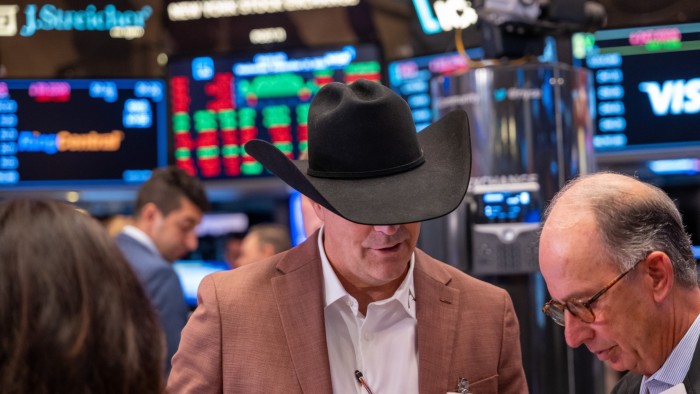US active ETFs and mutual funds outperform passive rivals

Simply sign up to the Exchange traded funds myFT Digest -- delivered directly to your inbox.
Latest news on ETFs
Visit our ETF Hub to find out more and to explore our in-depth data and comparison tools
More than half of US actively managed mutual funds and ETFs outperformed their average passive counterparts in the 12 months to the end of June, a Morningstar report shows.
The research showed 57 per cent of actively managed funds and ETFs outperformed their passive counterparts, a steep rise from the 43 per cent for the calendar year ended December 2022.
The Chicago-based researcher measures success by evaluating active funds against a benchmark of a composite of passive funds, reflecting the net-of-fees performance of investible passive funds. The analysis also considers how the average dollar invested in active funds has fared versus the average dollar invested in passive funds and examines trends in active fund success by fee level.
Morningstar also shows the distribution of surviving active funds’ excess returns versus their average passive peers to “help investors understand not just the odds of picking a successful manager but also the prospective payout or penalty”, the report says.

This article was previously published by Ignites, a title owned by the FT Group.
Active funds outperformed across asset classes and in nearly all categories tracked by the researcher, with corporate bond funds the holdout, the report shows.
Only 40 per cent outperformed passive rivals in that category during the year to the end of June.
Morningstar’s analysis includes 8,212 funds and ETFs that account for approximately $17tn in assets, or about 55.9 per cent of the US fund market as of June 30, the report said.
Active small-cap funds had a 65 per cent success rate (percentage that outperformed their average passive counterparts) compared with 56 per cent of active mid-cap funds and 53 per cent of active large-cap funds, up from 55.8 per cent, 49 per cent and 39 per cent, respectively, in June the previous year according to Morningstar.
Long-term success rates for active small-cap funds have generally been higher than those of large-cap funds, because the small-cap market is “relatively less liquid and efficiently priced,” the report said.
Active funds invested in international stocks saw the greatest year-over-year change, the report shows.
In the 12 months to the end of June, more than 63 per cent of those funds beat their average passive peer, up 30 percentage points from June the previous year. Active foreign equity funds were led by the foreign-large-cap-value category, which had a 75 per cent success rate for the period, the highest for any equity category.
Active bond funds also fared well this year, as 55 per cent of active bond managers beat the passive average, up from 30 per cent in June 2022, according to the report.
Active intermediate core bond funds tend to take more credit risk than indexed peers, which likely helped those funds this year after hurting them in 2022, as markets “rewarded credit risk after punishing it the year prior”, the report notes.
Latest news on ETFs

Visit the ETF Hub to find out more and to explore our in-depth data and comparison tools helping you to understand everything from performance to ESG ratings
But a banner year for active funds did not do much to change their long-term track record, the report notes.
Just one in four active strategies survived and beat their average passive counterparts over the 10 years that ended June 30. Long-term success is higher among foreign equities, real estate and bond funds, while it is lowest among US large-cap funds.
Overall, cheap active funds succeed more often than expensive ones, Morningstar noted.
About 31 per cent of active funds in the cheapest quintile beat their average passive peers compared with 19 per cent of those in the priciest quintile.
*Ignites is a news service published by FT Specialist for professionals working in the asset management industry. Trials and subscriptions are available at ignites.com.
Comments